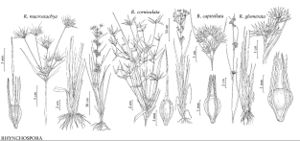Rhynchospora capitellata
Enum. Pl. 2: 235. 1805.
Plants perennial, cespitose, 20–100 cm; rhizomes absent. Culms arching-ascending, leafy, obtusely trigonous, slender; principal leaves overtopped by inflorescence; blades flat, to 3 mm, apex tapering, trigonous. Inflorescences terminal and axillary, clusters 1–5 or more, compact, turbinate or hemispheric, 1–1.5 cm wide; peduncles progressively shorter distally on culm; bracteal leaves mostly exceeding subtended compounds. Spikelets rich deep brown, rarely pale-brown, lanceellipsoid, 3.5–4 (–5) mm; fertile scale elliptic, 2.7–3 mm, apex acute or rounded, midrib shortexcurrent or not. Flowers: perianth absent. Fruits (1–) 2–3 (–5) per spikelet, (2–) 2.5–3 mm; body redbrown with pale central disc, stipitate, lenticular, obovoid, 1.2–1.5 × 0.7–1 (–1.2) mm, margins pale, wirelike, surfaces slick; tubercle triangularsubulate, (0.8–) 1–1.2 (–1.6) mm.
Phenology: Fruiting summer–fall.
Habitat: Moist to wet meadows, swales, seeps, stream banks, flatwoods, fens, and bogs
Elevation: 0–1600 m
Distribution

N.B., N.S., Ont., Que., Ala., Ark., Calif., Conn., Del., D.C., Fla., Ga., Ill., Ind., Kans., Ky., La., Maine, Md., Mass., Mich., Minn., Miss., Mo., N.H., N.J., N.Y., N.C., Ohio, Oreg., Pa., R.I., S.C., Tenn., Tex., Vt., Va., W.Va., Wis.
Discussion
Rhynchospora capitellata occurs infrequently in the lower Gulf coastal plain (in Florida, only north) and intergrades with R. glomerata. Forms with antrorsely barbellate bristles are referred to forma controversa (S. F. Blake) Gale; those with smooth bristles are named forma discutiens (C. B. Clarke) Gale (S. Gale 1944). Occasional forms with trigonous fruits occur.
Bruce Sorrie (pers. comm.) believes that many of the southern coastal plain records for Rhynchospora capitellata are based on examples of a neglected taxon, R. leptocarpa (Chapman) Small (J. K. Small 1933), and he wishes to reinstate it. Occurring in semi-shady moist sites in steepheads, or from seeps and shallows along blackwater streams, the plants are mostly distinguished by the tall, lax habit; the many distant, small clusters of light brown or tan spikelets; and the softer, more lax foliage. Measures of spikelets, fertile scales, perianth, achenes, and fruit tubercles show a strong overlap with those of southern examples of R. capitellata. The long, lax culm habit, the softer and paler foliage, and the paler spikelets could well be ecologic responses, or the plants could indeed represent a geographic variant.
Selected References
None.
Lower Taxa
"shortened" is not a number."wider" is not a number.
